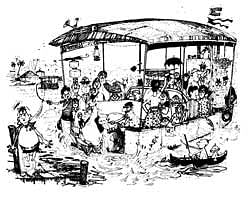
In more than one respect, the loss of Mario Miranda is the end of an era. An era that began with huge hips and rosy lips; of suspenders and pot bellies; of romance and laughter. Mario was about the heart.
His illustrations were powerful; with a few simple lines, he would capture the essence of people. He was able to see humour in just plain simple life, from the streets to the dining table to office meetings, funerals and family gatherings.
I first met Mario in my teens. He came backstage at Loutolim, to congratulate us for winning a one-act play competition. He waited with us and upon seeing that we had no transport to get back home, he sent his car to drop us to Benaulim. I knew then that I had met someone special.
Years later, when I was in Lucknow as a national awardee pursuing a career in fine arts and was training in restoration at INTACH Lucknow, Mario, the then convener of INTACH Goa, approached my director at Lucknow for a professional to set up the Christian Art Museum. It was then that I met Mario again and his humility and simplicity were still untainted. “Don’t call me sir, call me Mario,” he said.
A connection then made thus was never broken till the end. It was only because of Mario’s constant support that we worked out a concept and methodology and were able to put together an enviable collection for the Christian Art Museum then at Rachol.
During the course of those two years, while I had to document and archive Christian artefacts, I had to make some tough decisions. I was young and idealistic then and found it difficult to bend over and it was during such trying times that Mario proved to be my mentor.
Leafing through the letters he had written to me, I can’t help but smile, for, in every letter of his he tried to cheer me up and kept asking me to be more realistic and less passionate.
He wanted me to hang on and not cave in; he even flew from Mumbai to convince me not to resign as curator and when I finally did it, Mario resigned with me. This was the Mario I knew and grew fond of. As an older person, now I can look back and understand why he wanted me to stay on and I regret that I didn’t. Till recently, he defended my decision and stood by his principles. Such was the man.
Distinct style
Mario was one of the few cartoonists who published in most of the leading newspapers and magazines of India long before he retired to his sprawling mansion in Goa. His simplicity allowed him to see the lighter side of life. His signature caricatures are immortal.
Even though many generously borrowed his buxom women and suspended potbellies, and some even used them as their stepping stone to fame without ethical concerns or patency rights, ironically, they are Mario’s, and shall be Mario’s, no matter what. This is what Mario has left for everyone. If you walk into cafés, sidewalk restaurants, hotel lobbies in Bombay and Goa, Mario is there.
Mario had the gift of making even the most simple, drab looking scene seem pompous, and yet he was just the opposite — a very simple man. When I did the annual Great Music Revival series of concerts in Goa, Mario was always there in the audience, sketching the musicians on stage. When I visited him a couple of years ago, he was still sketching.
He steadied his shaky hands and let the figures take forms. Although he said that sketching kept him young, it saddened me to see a man of such repute as Mario still negotiating for work. Somehow, we made him forget the value of his signature. The signature that gave an identity to our tinto (market place), our careira (bus), our poder (baker) and our padre (vicar).
Silent efforts
But Mario’s initiatives are many for Goa and Goans. He was always concerned of Goa’s heritage and monuments. When he was the convener of INTACH Goa, and even later, he would fly down from Mumbai to Goa to fight for causes of preservation of heritage monuments.
I remember attending meetings on preservation with him and his friend, architect Sarto Almeida. We attended meetings and meetings — such was his silent effort that go unmentioned. He would singlehandedly persevere without any group matrix or band wagons.
That, from the Christian Art Museum he initiated and worked towards procuring funds for the restoration of the Reis Magos Fort and St Anne Church needs to be applauded. His initiatives are a testimony to the simplicity of the man and his love for Goa and its heritage and culture.
In the last few years, even with failing health, he did not hesitate to lend his name to any initiative or aspiring artistic endeavour. He didn’t have to, but he did. Taking the support of his walking stick, he would be there. It kept him young, he said.
It was his dream that we start a consultancy art base to organise art exhibitions, develop art galleries, sponsor new artists and raise funds for the cause of restoration of monuments.
In his many letters through the years, his encouragement has led to my own documentation and restoration of Goa’s ethnography through the Goa Chitra Museum.
We may not have Mario with us today, but his work and spirit shall live on forever in our hearts. As Goa completes 50 years of its liberation tomorrow, December 19, 2011, let’s hope at least one of the art centres here in Goa is named after one of its illustrious sons, Mario de Miranda.
(The writer is the curator of Goa Chitra Museum.)